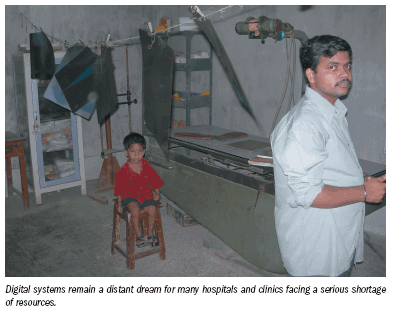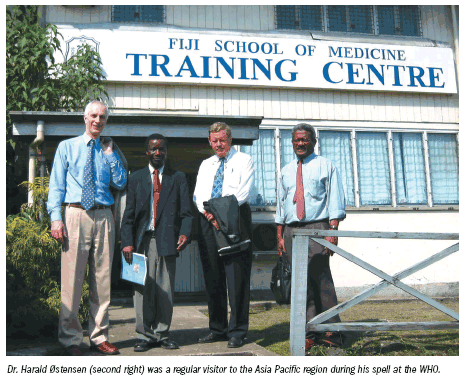Back to basics: imaging in countries with limited resources
In countries where resources are limited, only a few wealthy individuals have access to well-equipped, properly staffed private healthcare institutions.
In countries where resources are limited, only a few wealthy individuals have access to well-equipped, properly staffed private healthcare institutions. The majority of the population will be treated in poorly equipped government-funded hospitals and clinics that have insufficient staff and are barely operational. Any imaging equipment that is available is likely to be malfunctioning and used incorrectly. Lengthy breakdowns due to lack of proper maintenance and spare parts are common. Outside of the larger cities, virtually no access to diagnostic imaging services will be available.
The poor quality of diagnostic imaging services in less developed countries is often due to ignorance about the value of imaging technology. Plans for developing nationwide health services are frequently based on recommendations from international “experts” who live and work under conditions where “everything” is available and possible. Attempts to transform practically nonexistent health systems into systems fit for more affluent countries, virtually overnight, have failed in the past. Nothing suggests that this strategy will be more successful in the future.
The root of the problem is usually a lack of technical and medical know-how combined with insufficient basic equipment and infrastructure. Even well-educated and properly trained technologists/radiographers can do little to improve the quality of x-ray services if they do not have proper facilities for developing films. Darkrooms are often insufficiently protected from intruding daylight, and water needed for film processing is seldom clean. It can also be extremely difficult to keep water and processing chemicals cool enough. Working temperatures of 40°C are not unusual under tropical conditions.
No one other than properly educated and licensed radiographers/radiological technologists should be allowed to operate x-ray machines. This is important if diagnostic-quality images are to be produced safely without exposing patients and/or staff to unnecessary radiation. Fortunately, the majority of x-ray operators do receive a relatively good basic training, though they have few opportunities to update their knowledge through continuing education programs.
In an ideal world, only well-trained and certified medical specialists, typically radiologists, would interpret x-ray examinations. Such people are rarely found in small and midsized hospitals in countries with limited resources. Image interpretation is left to staff with insufficient radiological training. Most qualified radiological specialists tend to move to the larger cities and find employment in private institutions where conditions, including salaries, are much more attractive. There is also a serious brain drain to more affluent countries.
So what can be done? Probably the most important task is to substitute chemical film processing with a digital solution. The diagnostic quality of images produced with simple digital radiography solutions is much better than that of conventionally generated images.

This switch is often relatively affordable. There is no need to spend thousands on the latest high-tech system. Electronic detectors that are used instead of film cassettes can be bought for US$30,000 to US$60,000. Initial sometimes be financed by savings in film and chemicals, allowing sites to break even after two or three years.

The solution to the lack of medical specialists may be to send images electronically to another institution where radiologists are available. Sites using digital radiography systems should be able to do this easily, given that most have access to e-mail. Compressed x-ray images saved as jpg files and sent as attachments are sufficient for urgent diagnostic evaluation in most cases. Broadband is desirable but not essential. Such a system will require formal collaboration with the receiving site and some sort of remuneration for the doctor reading the images, but it is doable.
Upgrades to small and midsized hospitals in remote locations do not attract media attention. Politicians thinking about headlines and reelection may choose to support the purchase of an extremely expensive item of high-tech medical equipment that may appear to benefit a population. In reality, it will not be utilized properly. Guidelines from international organizations stating that “Every district hospital should at least have one CT machine” may also lead Dr. Harald Østensen (second right) was a regular visitor to the Asia Pacific region during his spell at the WHO. Digital systems remain a distant dream for many hospitals and clinics facing a serious shortage of resources. to inappropriate donations. Too many hospitals in poor countries have unused CT scanners that may not even have been installed.
No healthcare system can function properly without the necessary bits and pieces in place. An adequate and appropriate diagnostic imaging service is one of these bits.
Can Abbreviated MRI Have an Impact in Rectal Cancer Staging?
April 4th 2025Abbreviated MRI demonstrated a 95.3 percent specificity for rectal cancer and provided strong agreement with the full MRI protocol for T staging and detection of extramural venous invasion, according to newly published research.
The Reading Room Podcast: Current Perspectives on the Updated Appropriate Use Criteria for Brain PET
March 18th 2025In a new podcast, Satoshi Minoshima, M.D., Ph.D., and James Williams, Ph.D., share their insights on the recently updated appropriate use criteria for amyloid PET and tau PET in patients with mild cognitive impairment.
GE HealthCare Debuts AI-Powered Cardiac CT Device at ACC Conference
April 1st 2025Featuring enhanced low-dose image quality with motion-free images, the Revolution Vibe CT system reportedly facilitates improved diagnostic clarity for patients with conditions ranging from in-stent restenosis to atrial fibrillation.